Introduction: A Scion of Artistic Royalty
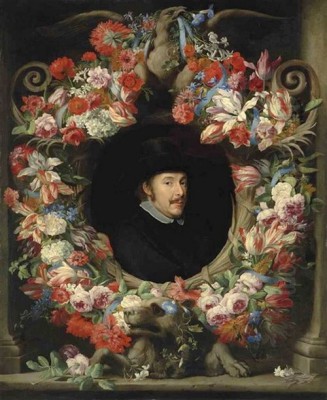
Abraham Brueghel stands as a significant figure in the rich tapestry of 17th-century European art. Born in Antwerp in 1631 and passing away in Naples in 1697, he was a Flemish painter who carved his niche primarily in the sun-drenched landscapes of Italy. His name resonates not only for his own considerable talent but also due to his illustrious lineage; he was the son of Jan Brueghel the Younger, grandson of the celebrated Jan Brueghel the Elder (known as 'Velvet' Brueghel), and the great-grandson of the legendary Pieter Bruegel the Elder, patriarch of the Brueghel artistic dynasty. While deeply rooted in the Flemish tradition, Abraham masterfully adapted his heritage to the prevailing Baroque tastes of Italy, becoming a renowned specialist in still life painting, particularly celebrated for his opulent depictions of fruits and flowers.
His journey from the bustling art centre of Antwerp to the vibrant cities of Rome and Naples marks a fascinating chapter in the cross-pollination of artistic ideas between Northern and Southern Europe. Abraham Brueghel, sometimes known by the nicknames 'Napolitano' or 'Ryngraaf', successfully synthesized the meticulous detail characteristic of Flemish painting with the dramatic flair and sensuousness of the Italian Baroque, leaving behind a legacy of visually stunning and technically accomplished works that continue to captivate viewers today.
Early Life and Artistic Formation in Antwerp
Abraham Brueghel's artistic journey began in the heart of Antwerp, a city renowned for its dynamic art scene and the formidable legacy of his own family. Born into the Brueghel dynasty, art was not merely a profession but a birthright. His earliest training took place within the active workshop of his father, Jan Brueghel the Younger (1601-1678). Jan the Younger, himself a successful painter, continued the family tradition, specializing in landscapes, allegorical scenes, and flower still lifes, often collaborating with other prominent artists like Peter Paul Rubens, just as his own father, Jan the Elder, had done.
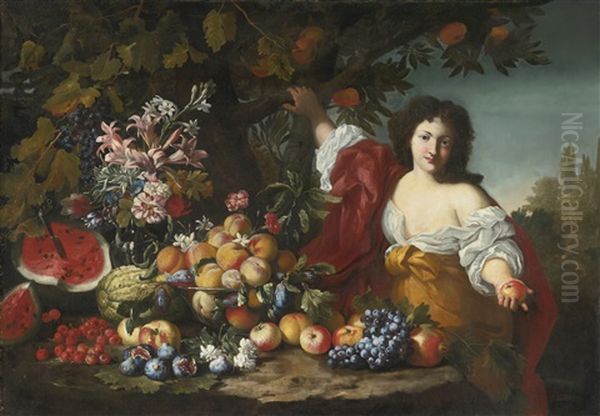
Under his father's tutelage, Abraham would have absorbed the fundamental techniques and stylistic preferences that defined the Brueghel brand: a keen eye for detail, a love for vibrant colour, and a mastery in rendering textures. The Brueghel workshop was a hub of activity, producing works that were highly sought after across Europe. Young Abraham demonstrated considerable talent early on, quickly mastering the skills necessary to contribute to the workshop's output and eventually develop his own artistic voice. This formative period instilled in him the meticulous naturalism that would remain a hallmark of his work, even as he later embraced the dynamism of the Baroque.
The legacy of his grandfather, Jan Brueghel the Elder (1568-1625), and great-grandfather, Pieter Bruegel the Elder (c. 1525-1569), loomed large. Pieter the Elder's profound insights into peasant life and landscape painting, and Jan the Elder's exquisite flower pieces and allegorical landscapes, formed the bedrock upon which subsequent generations built. Abraham inherited this rich artistic DNA, providing him with an exceptional foundation as he prepared to make his own mark on the world.
The Call of Italy: A New Artistic Horizon
Like many Northern European artists of his time, Abraham Brueghel felt the magnetic pull of Italy, the cradle of the Renaissance and the vibrant centre of the burgeoning Baroque movement. He travelled south relatively early in his career, likely before 1649. Evidence suggests his presence in Italy by this time, as he is documented as having completed a significant commission for Don Antonio Ruffo, a prominent Sicilian nobleman and discerning art collector based in Messina. This commission reportedly involved nine flower paintings, indicating that Abraham, still a young man, had already achieved a level of skill sufficient to attract high-profile patronage.
This early immersion in the Italian artistic environment was crucial for Brueghel's development. Italy offered a different light, different colours, and different artistic priorities compared to Antwerp. While Flemish art often emphasized detailed realism and intricate surfaces, Italian art, particularly the ascendant Baroque style, favoured drama, dynamism, and emotional intensity. Exposure to the works of Italian masters, both past and contemporary, would have profoundly impacted his artistic vision. The Ruffo commission not only provided valuable experience and recognition but also marked the beginning of his long and fruitful engagement with Italian patrons and the Italian art world.
Roman Sojourn: Embracing the Baroque
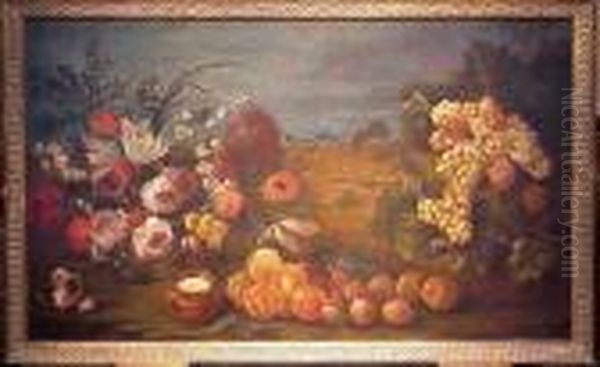
Following his initial work, likely centred around Sicily and Southern Italy, Abraham Brueghel spent a significant period in Rome. The Eternal City during the mid-17th century was an unparalleled artistic melting pot, pulsating with the energy of the High Baroque. It was the city of Gian Lorenzo Bernini's sculptural and architectural marvels and still resonated with the revolutionary naturalism and dramatic chiaroscuro of Caravaggio, whose influence continued to permeate Roman painting. Artists from across Europe flocked to Rome to study antiquities, learn from contemporary masters, and compete for prestigious commissions from the Church and powerful aristocratic families.
While specific details of Brueghel's Roman activities are not extensively documented in the provided sources, it was during this period, or perhaps bridging his time in Rome and Naples, that he likely began incorporating more pronounced Baroque elements into his work. The emphasis on dynamic compositions, rich, deep colours, and dramatic interplay of light and shadow, characteristic of Roman Baroque painting, started to infuse his Flemish precision. It is known that he collaborated with other artists active in Italy. One notable collaborator was Guillaume Courtois (Guglielmo Cortese), a French-born painter active primarily in Rome, known for his historical and religious scenes. Their joint works likely involved Brueghel painting the still-life elements within Courtois's larger compositions, a common practice at the time.
This Roman period was essential for Brueghel's transition. He absorbed the grandeur and theatricality of the Italian Baroque, learning to combine the meticulous observation inherited from his Flemish background with a newfound sense of movement and opulence. This synthesis would become the hallmark of his mature style, which fully blossomed upon his move further south.
Naples: The Adopted Homeland and Artistic Zenith
Around the 1670s (sources suggest a move possibly by 1674 or 1675, though he had connections earlier), Abraham Brueghel settled in Naples. This vibrant, bustling port city, then under Spanish rule, had its own distinct and flourishing artistic identity. Neapolitan art of the period was characterized by a powerful blend of Caravaggesque naturalism, Spanish intensity, and exuberant Baroque decoration, exemplified by artists like Jusepe de Ribera, Luca Giordano, and Salvator Rosa. Brueghel found a receptive environment for his talents in Naples, and it was here that he spent the most productive and defining part of his career, earning him the nickname 'Napolitano'.
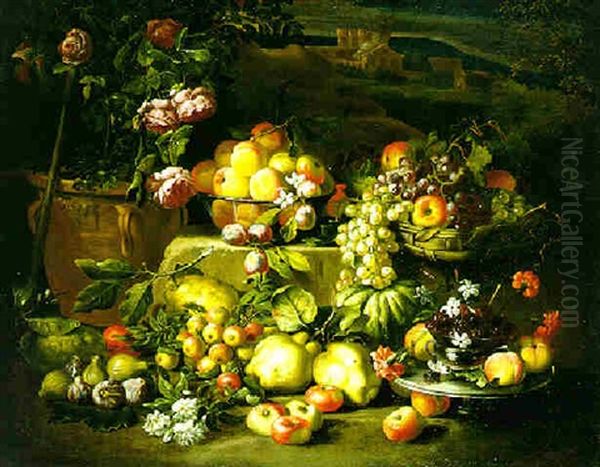
In Naples, Brueghel solidified his reputation as a leading master of still life. He specialized in lavish arrangements of fruits and flowers, often depicted spilling out of baskets or arranged against dramatic, shadowy backgrounds. His Neapolitan works are characterized by their rich textures, deep, saturated colours, and a sense of abundant vitality. He masterfully captured the glistening surfaces of grapes, the velvety skin of peaches, and the delicate translucency of flower petals, all rendered with Flemish precision but imbued with Baroque energy and scale. These compositions were highly sought after by Neapolitan collectors and the Spanish viceroys.
He continued to collaborate with local artists in Naples. A significant collaborator was the Neapolitan painter Nicola Vaccaro (1640-1709). Vaccaro, known for his versatility in handling figures and various genres, often added human figures or architectural settings to Brueghel's sumptuous still-life arrangements. Their joint works seamlessly blended Brueghel's expertise in rendering natural objects with Vaccaro's skill in figurative painting, resulting in complex allegorical or decorative compositions that were highly prized.
Artistic Style: Flemish Detail Meets Baroque Splendour
Abraham Brueghel's artistic style represents a masterful fusion of his Northern European heritage and his adopted Italian environment. At its core, his work retains the meticulous attention to detail and the faithful rendering of textures that were hallmarks of the Brueghel dynasty and Flemish painting in general. He possessed an extraordinary ability to observe and replicate the natural world, capturing the unique characteristics of each fruit, flower, or object with remarkable precision. This commitment to naturalism provided a solid foundation for his compositions.
However, Brueghel did not simply replicate the style of his ancestors. Living and working in Italy during the height of the Baroque era, he embraced the movement's key characteristics. His compositions became more dynamic and complex than traditional Flemish still lifes. He often employed diagonal lines, cascading arrangements, and a sense of overflowing abundance that conveyed energy and movement. His use of colour became richer and more dramatic, employing deep shadows and strong highlights (chiaroscuro) to create a sense of volume and theatricality. This dramatic lighting enhanced the sensuous quality of the objects he depicted, making the fruits appear more luscious and the flowers more vibrant.

His themes primarily revolved around the bounty of nature – arrangements of flowers, fruits, and occasionally game or animals. These were not mere decorative pieces; they often carried symbolic meanings related to abundance, the transience of life (vanitas), or the seasons, common themes in Baroque still life. His work is often described as decorative Baroque still life, emphasizing its suitability for adorning the lavish interiors of palaces and aristocratic homes. He played a significant role within the context of Neapolitan painting, contributing to the city's reputation as a major centre for still-life painting in the latter half of the 17th century.
Representative Works: Capturing Nature's Abundance
While many of Abraham Brueghel's works reside in collections worldwide, a few stand out as representative of his style and skill. The provided texts highlight two specific works, although the title of the first seems slightly ambiguous in translation.
One notable work, described as potentially titled Fruit and a Boorish Man or perhaps better understood as Still Life with Fruit and a Figure, is dated to around 1675. This period aligns with his move to or early years in Naples. The description mentions a "half-figure" treatment, suggesting a composition where a human figure interacts with or is juxtaposed against a lavish display of fruit. This type of painting, combining still life with genre elements, was popular during the Baroque period. The source compares its style to signed and dated works from the mid-1670s found in institutions like the Museum Boijmans Van Beuningen in Rotterdam, indicating a consistency in his approach during this phase. This work likely showcases his mature Neapolitan style, blending detailed fruit rendering with a human element, possibly painted by a collaborator.
Another key piece mentioned is Flowers in a Pewter Vase, Grapes and Peaches, dated earlier, around 1650. This oil on canvas likely represents his work during his initial Italian period, possibly Rome. As the title suggests, it focuses purely on the still-life elements. Works from this period might show a stronger connection to his Flemish roots while beginning to incorporate the richer palette and more dynamic composition learned in Italy. It would display his early mastery in capturing the delicate textures of flowers and the succulent appearance of fruits, arranged within a composition that balances Northern precision with emerging Baroque sensibilities. These works exemplify Brueghel's ability to create visually stunning arrangements that celebrate the beauty and richness of the natural world through the lens of Baroque aesthetics.
Collaborations, Connections, and Patronage
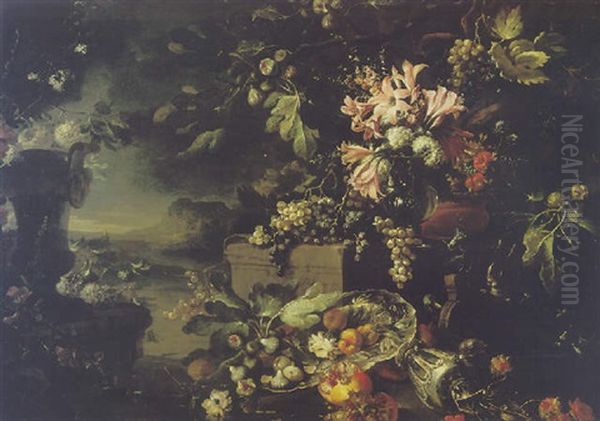
Abraham Brueghel's success in Italy was facilitated not only by his talent but also by his ability to navigate the complex social and artistic networks of Rome and Naples. His collaborations were crucial. Working with figure painters like Guillaume Courtois in Rome and Nicola Vaccaro in Naples allowed him to participate in larger, more complex commissions, broadening his appeal. These partnerships were mutually beneficial, combining specialized skills to create integrated works of art that were highly fashionable.
His connections extended to influential patrons and collectors. The early commission from Don Antonio Ruffo in Sicily was a significant start. In Naples, he cultivated relationships with important figures. The source mentions friendships with the Gaspare Roomer (or Roomet) family and Flavio Ruffo (Antonio's son, who also moved to Naples). The Roomer family, originally Flemish merchants, were prominent art collectors in Naples, and their patronage would have been invaluable. Flavio Ruffo's presence in Naples likely also provided continued support and connections within the Neapolitan elite.
Furthermore, Brueghel secured patronage from some of the highest levels of society. Don Gaspar de Haro y Guzmán, the 7th Marquis of Carpio, a major Spanish diplomat and one of the most important art collectors of the late 17th century, commissioned works from him. Such high-level patronage cemented Brueghel's status and ensured the desirability of his paintings. His reputation was also bolstered by positive critical reception; the Neapolitan art historian and painter Bernardo De Dominici, writing in the early 18th century, praised Brueghel's "fluent and natural" brushwork and his beautiful, truthful use of colour, confirming his esteemed position in the Neapolitan art scene.
Continuing the Brueghel Legacy in a New Land
Abraham Brueghel occupies a unique position within the celebrated Brueghel dynasty. While his great-grandfather Pieter Bruegel the Elder focused on landscapes and peasant scenes, and his grandfather Jan Brueghel the Elder excelled in detailed allegorical landscapes and flower pieces (often collaborating with Rubens), Abraham specialized almost exclusively in still life, particularly the opulent Baroque style favoured in Italy. His father, Jan Brueghel the Younger, largely continued the styles established by Jan the Elder, running a successful workshop but perhaps with less innovation than his forebears or his son Abraham.
Abraham took the family's core strengths – meticulous technique, vibrant colour, love of nature – and successfully transplanted them into a different cultural and artistic context. He adapted the Brueghel tradition to meet the demands of Italian Baroque taste, embracing greater dynamism, drama, and sensuousness than typically found in earlier Flemish still lifes, even those by masters like Frans Snyders or Osias Beert. He demonstrated that the Brueghel legacy was not static but could evolve and thrive in new environments.
While the sources do not name specific students trained directly by Abraham Brueghel, his influence was significant. His success and distinctive style undoubtedly impacted other still-life painters active in Naples and Rome during the late 17th century. He set a high standard for decorative still life, demonstrating how Northern precision could be effectively combined with Southern European grandeur. His work serves as a testament to the adaptability and enduring appeal of the Brueghel artistic heritage. The art historian Gustav Glück's inclusion of some of his works (perhaps initially misattributed) in studies of the Brueghel family further underscores his connection and importance within this artistic lineage.
Later Years and Enduring Influence
Abraham Brueghel remained active as a painter until around 1690, continuing to produce the lavish still lifes that had brought him fame and fortune in his adopted Italy. He passed away in Naples in 1697, leaving behind a substantial body of work that secured his reputation as one of the leading still-life painters of the Italian Baroque. His paintings were highly valued during his lifetime and continued to be sought after by collectors.
His influence extended beyond his immediate circle. By successfully merging Flemish and Italian artistic traditions, he contributed to the rich cultural exchange that characterized 17th-century European art. His work provided a model for how Northern European precision and detail could be integrated with the dynamism and decorative impulses of the Italian Baroque. His opulent arrangements of fruits and flowers became archetypes of Baroque still life, influencing subsequent generations of painters specializing in the genre, particularly within Naples.
Today, Abraham Brueghel's works are held in major museums and private collections around the world. They are admired for their technical brilliance, their vibrant celebration of nature's bounty, and their embodiment of the Baroque era's aesthetic ideals. He stands as a crucial link between the artistic traditions of Northern and Southern Europe and as a testament to the enduring power and adaptability of the Brueghel family's artistic genius.
Conclusion: A Master of Transcultural Baroque
Abraham Brueghel's life and career offer a compelling narrative of artistic adaptation and success. Born into the most famous artistic dynasty of the Low Countries, he carried the weight of expectation and the inheritance of exceptional skill. Yet, rather than simply replicating the formulas of his ancestors, he forged his own path, embracing the artistic currents of Italy and becoming a master in his own right. His move to Italy proved transformative, allowing him to synthesize the meticulous realism of his Flemish training with the dramatic energy and opulent aesthetics of the Baroque.
As a specialist in still life, particularly fruit and flower painting, Brueghel achieved remarkable success, especially during his long Neapolitan period. His works are dazzling displays of technical virtuosity, capturing the textures, colours, and vitality of nature with breathtaking skill, all while composing them with a dynamic, theatrical flair suited to the grand interiors of his patrons. Through collaborations, strategic connections, and undeniable talent, he established himself as a leading figure in the Italian art world. Abraham Brueghel remains a significant artist, celebrated for his beautiful compositions and for his role as a bridge between the artistic worlds of Flanders and Italy during the vibrant Baroque era.